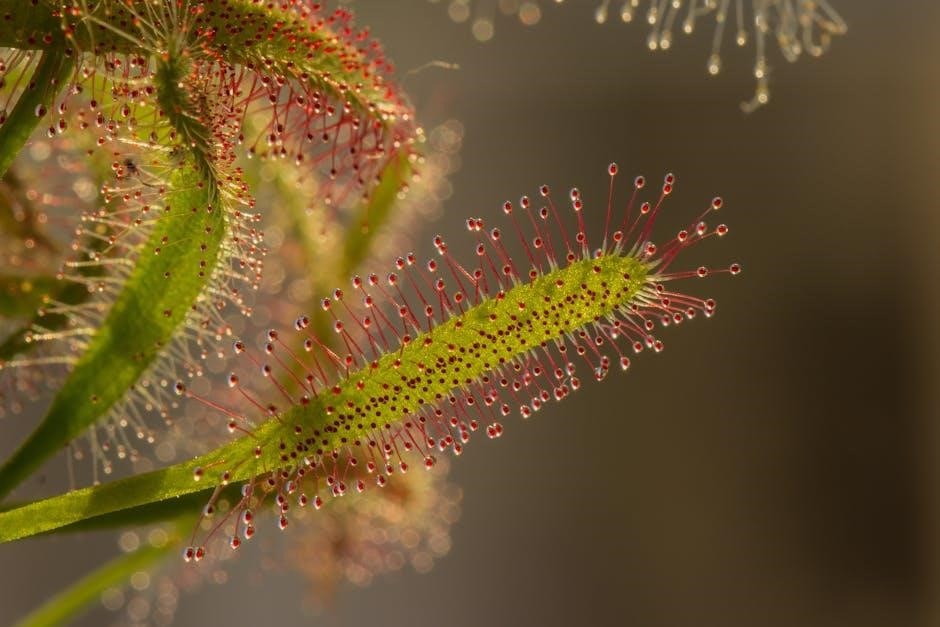study guide photosynthesis
Photosynthesis is a vital biological process where plants, algae, and some bacteria convert light energy into chemical energy, producing oxygen and organic compounds essential for life.
1.1 Definition of Photosynthesis
Photosynthesis is the process by which plants, algae, and some bacteria convert light energy from the sun into chemical energy, producing glucose and oxygen. It is a vital biological process that supports life on Earth by providing energy and organic compounds.
1.2 Importance of Photosynthesis in Ecosystems
Photosynthesis is crucial for ecosystems as it provides oxygen and organic compounds, supporting nearly all life forms. It forms the base of food chains, sustaining herbivores and, indirectly, carnivores. Additionally, it regulates Earth’s climate by absorbing carbon dioxide, making it essential for environmental balance and sustaining biodiversity.
1.3 Overview of the Photosynthesis Process
Photosynthesis converts light energy into chemical energy, using carbon dioxide, water, and sunlight to produce glucose and oxygen. It occurs in chloroplasts, involving light-dependent reactions (producing ATP and NADPH) and light-independent reactions (Calvin Cycle, synthesizing glucose). This process sustains life by providing energy and organic compounds.

The Chloroplast and Its Structure
The chloroplast is a plant cell organelle with a double membrane, containing stroma and thylakoids, where photosynthesis occurs, using chlorophyll to absorb light energy;
2.1 Structure of a Chloroplast
A chloroplast has a double membrane enclosing a gel-like stroma. Inside are thylakoids, stacked into grana, and chlorophyll pigments essential for absorbing light energy. This structure optimizes light capture and chemical reactions, enabling efficient photosynthesis.
2.2 Role of Grana, Stroma, and Thylakoids
Grana are stacks of thylakoid membranes where light-dependent reactions occur, housing pigments and enzymes for energy conversion. The stroma, surrounding the grana, is the site of the Calvin cycle, producing glucose. Thylakoids facilitate ATP synthesis, while the stroma’s enzymes drive carbon fixation, together enabling photosynthesis.
2.3 Function of Chlorophyll in Photosynthesis
Chlorophyll is a green pigment embedded in thylakoid membranes of grana, enabling plants to absorb light energy, primarily in blue and red wavelengths. It transfers this energy to other molecules, driving the production of ATP and NADPH in light-dependent reactions, essential for photosynthesis to occur.

The Process of Photosynthesis
Photosynthesis converts light energy into chemical energy, producing glucose and oxygen. It involves light-dependent reactions in thylakoids and light-independent reactions in the stroma, essential for life on Earth.
3.1 Inputs and Outputs of Photosynthesis
Photosynthesis requires water, carbon dioxide, and light energy as inputs. These are converted into glucose (energy-rich organic compound) and oxygen as outputs. Water is split in light reactions, while CO2 is fixed in the Calvin cycle, producing glucose and releasing oxygen as a byproduct.
3.2 The Chemical Equation for Photosynthesis
The balanced chemical equation for photosynthesis is: 6CO₂ + 6H₂O + Light Energy → C₆H₁₂O₆ + 6O₂. This equation shows carbon dioxide and water reacting with light energy to produce glucose and oxygen, summarizing the overall process and its essential reactants and products.
3.3 Step-by-Step Explanation of the Process
Photosynthesis occurs in chloroplasts through two stages. First, light reactions absorb light energy, splitting water into oxygen, ATP, and NADPH. Next, the Calvin Cycle uses ATP and NADPH to fix CO₂ into glucose via RuBP regeneration and carbon fixation, ultimately producing oxygen as a byproduct.

The Light-Dependent Reactions
Light-dependent reactions occur in thylakoid membranes, converting light energy into ATP and NADPH by splitting water, with pigments and electron transport chains facilitating the process.
4.1 Location and Purpose of Light Reactions
The light-dependent reactions occur in the thylakoid membranes of chloroplasts. Their primary purpose is to capture light energy, split water molecules, and produce ATP and NADPH for the Calvin cycle.
4.2 Production of ATP and NADPH
In the light-dependent reactions, energy from sunlight is absorbed by chlorophyll and other pigments, driving the production of ATP and NADPH. These energy-rich molecules are essential for powering the Calvin cycle, where CO2 is fixed into glucose.
4.3 Role of Pigments and Electron Transport Chains
Pigments like chlorophyll absorb light energy, initiating electron transfer. Electron transport chains harness this energy to produce ATP and NADPH. These molecules power the Calvin cycle, enabling CO2 fixation and glucose synthesis, while water molecules are split to release oxygen.

The Calvin Cycle (Light-Independent Reactions)
The Calvin Cycle converts CO2 into glucose using RuBP and energy from ATP and NADPH. It occurs in the stroma, regenerating RuBP and producing oxygen as a byproduct.
5.1 Overview of the Calvin Cycle
The Calvin Cycle is a critical light-independent reaction in photosynthesis. It occurs in the chloroplast stroma, fixing CO2 into glucose using RuBP, ATP, and NADPH. This cycle regenerates RuBP and produces oxygen, essential for sustaining life and energy production in plants and photosynthetic organisms. It’s a key process in converting carbon dioxide into energy-rich molecules.
5.2 Fixation of Carbon Dioxide
Carbon dioxide fixation is the second phase of the Calvin Cycle, where CO2 is attached to RuBP (ribulose-1,5-bisphosphate) by the enzyme RuBisCO, forming a 6-carbon intermediate. This intermediate splits into two 3-carbon molecules (PGA), which are reduced to form glucose. This step is crucial for converting CO2 into energy-rich organic compounds.
5.3 Production of Glucose and Regeneration of RuBP
In the Calvin Cycle, glucose is produced when PGA (3-phosphoglycerate) is reduced using ATP and NADPH from the light reactions. RuBP (ribulose-1,5-bisphosphate) is regenerated, allowing the cycle to continue. This step ensures the continuous fixation of CO2 and the production of energy-rich molecules essential for plant growth and development.
Importance of Photosynthesis
Photosynthesis is crucial for life, providing oxygen, forming the base of the food chain, and supporting ecosystems by converting light energy into chemical energy for organisms.
6.1 Role in Providing Oxygen and Food
Photosynthesis is essential for producing oxygen, released as a byproduct, and glucose, which serves as energy-rich food for plants and, indirectly, for herbivores and carnivores, forming the foundation of the food chain.
6.2 Supporting Life on Earth
Photosynthesis underpins life by converting light energy into chemical energy, sustaining ecosystems. It provides oxygen for respiration and glucose for food, supporting the food chain and enabling life to thrive across the planet.
6.3 Impact on Climate and Environment
Photosynthesis regulates Earth’s climate by absorbing CO2, a greenhouse gas, and releasing oxygen, vital for life. It supports ecosystems, moderates weather patterns, and helps mitigate climate change by reducing atmospheric carbon levels, ensuring environmental balance and sustaining biodiversity.

Factors Affecting Photosynthesis
Light intensity, temperature, CO2 levels, and water availability significantly influence photosynthesis. These factors can enhance or limit the process, impacting overall plant growth and productivity.
7.1 Light Intensity and Photoinhibition
Light intensity greatly affects photosynthesis, with optimal levels boosting productivity. However, excess light causes photoinhibition, damaging thylakoids and chlorophyll, reducing efficiency. Plants recover slowly in low-light conditions, emphasizing the balance needed for healthy photosynthesis.
7.2 Temperature and CO2 Levels
Temperature influences enzyme activity, with optimal levels enhancing photosynthesis. High temperatures can denature enzymes, reducing efficiency. CO2 levels also play a critical role, as low concentrations limit the Calvin cycle, directly impacting glucose production and overall photosynthetic efficiency.
7.3 Water Availability and Drought Stress
Water is essential for photosynthesis, serving as a reactant and coolant. Drought stress reduces stomatal conductance, limiting CO2 absorption and decreasing photosynthetic efficiency. Prolonged water scarcity can damage chlorophyll and disrupt electron transport chains, leading to photoinhibition and reduced plant productivity.

Photosynthesis in Different Organisms
Photosynthesis occurs in plants, algae, and cyanobacteria, each adapting to their environments. These organisms use sunlight, CO2, and water to produce energy, supporting life and oxygen production across ecosystems.
8.1 Photosynthesis in Plants and Algae
Photosynthesis in plants and algae occurs in chloroplasts, where chlorophyll captures light energy. They use carbon dioxide and water to produce glucose and oxygen, supporting growth and providing energy for ecosystems. This process is essential for plant survival and serves as the primary energy source for many organisms.
8.2 Photosynthesis in Cyanobacteria
Cyanobacteria are photosynthetic prokaryotes lacking chloroplasts, performing photosynthesis directly in thylakoid membranes. They use water and carbon dioxide, producing oxygen and organic compounds. Their ability to fix nitrogen enhances soil fertility, making them ecologically vital, and they contribute significantly to aquatic ecosystems and global oxygen production.
8.3 Unique Adaptations in Different Species
Plants and organisms exhibit unique adaptations to optimize photosynthesis. C4 plants separate initial CO2 fixation, while CAM plants fix CO2 at night. Shade plants have larger chloroplasts, enhancing light capture. Desert species reduce water loss through specialized stomata. These adaptations ensure survival and efficiency in diverse environments.

Applications and Research in Photosynthesis
Research focuses on enhancing crop yields, advancing artificial photosynthesis, and exploring its potential in sustainable energy. Recent discoveries aim to optimize efficiency and adapt to climate challenges.
9.1 Improving Crop Yields
Research aims to enhance crop yields by optimizing photosynthetic efficiency. Scientists focus on improving Rubisco function, a key enzyme, and studying light-energy conversion to boost plant productivity. Advanced methods include genetic engineering and mathematical modeling to simulate optimal photosynthetic processes under varying conditions, ensuring food security and sustainability in agriculture.
9.2 Advances in Artificial Photosynthesis
Breakthroughs in artificial photosynthesis include observing photosynthesis initiation at the single-photon level, offering insights into energy conversion. New approaches aim to enhance efficiency beyond biological limits, focusing on sustainable energy production and food security, potentially revolutionizing how we harness light energy.
9.3 Recent Scientific Discoveries
Recent studies reveal breakthroughs in understanding water constraints on photosynthesis and advancements in artificial systems mimicking photosynthesis. Researchers observed single-photon initiation of photosynthesis, offering insights into energy conversion. Additionally, new mathematical models and machine learning approaches are enhancing predictions of photosynthetic efficiency under varying conditions, paving the way for sustainable solutions.

Study Tips and Resources
Utilize study guides, flashcards, and interactive tools like the Interactive Biology Multimedia program. Practice with quizzes and review clear diagrams to master photosynthesis concepts effectively.
10.1 Key Vocabulary and Concepts
Master terms like photosynthesis, chlorophyll, chloroplast, light-dependent reactions, and Calvin cycle. Understand ATP, NADPH, and electron transport chains. Grasp the roles of stomata, thylakoids, and grana in the process. These concepts are foundational for understanding how photosynthesis converts light energy into chemical energy.
10.2 Recommended Study Materials
Use textbooks, online guides, and interactive tools like diagrams and flashcards. Khan Academy, Crash Course, and Quizlet offer excellent resources. Diagrams of chloroplasts and the Calvin cycle are essential. Flashcards can help memorize terms like photosynthesis, chlorophyll, and ATP. Utilize study guides and scientific articles for in-depth learning.
10.3 Practice Questions and Quizzes
Engage with multiple-choice questions, true/false statements, and fill-in-the-blank exercises to test your understanding. Use online platforms like Quizlet or Khan Academy for interactive quizzes. Practice labeling diagrams of chloroplasts and the Calvin cycle. Review end-of-chapter questions in textbooks to reinforce key concepts and identify areas for further study.


